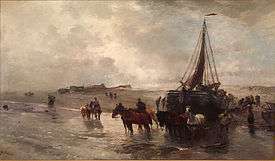Gregor von Bochmann


Gregor von Bochmann (1 June 1850, Nehatu - 12 February 1930, Hösel, near Düsseldorf) was a Baltic-German landscape and genre painter.
Biography
His father was a forest warden for the Governorate of Estonia.[1] Bochmann frequently travelled around the country with him, developing his ability to observe nature. From 1862 to 1868, he studied at the Gustav Adolf Grammar School in Tallinn, where his art teacher, Theodor Albert Sprengel (1832-1900), recognized his talent and obtained a scholarship for him to study at the Kunstakademie Düsseldorf.[1]
He attended the landscape class of Oswald Achenbach and, after graduation in 1871, established his own studios nearby. Further study trips were made to Holland, Belgium and his native Estonia and the sketches he made there served as the basis for much of his later work. In 1877, he married Emilie Poensgen, the daughter of industrialist Julius Poensgen, an iron and steel manufacturer.[1]
He exhibited widely, notably at the Exposition Universelle (1878), and received numerous awards. In 1893, he became a member of the Academy of Arts, Berlin and, two years later, was awarded the title of "Royal Prussian Professor".[1] In 1899, he was granted a title of nobility by Kaiser Wilhelm II.
References
- 1 2 3 4 Paul Campe (1955), "Bochmann, Alexander Heinrich Gregor von", Neue Deutsche Biographie (NDB) (in German), 2, Berlin: Duncker & Humblot, p. 340; (full text online)
Further reading
- Julia Hümme: Gregor von Bochmann (1850–1930). Leben und Werk eines deutsch-baltischen Malers in Düsseldorf (Dissertation). Verlag Ludwig, Kiel, 2007, ISBN 978-3-937719-31-3
- Silke Köhn: Gregor von Bochmann 1850–1930. Sammler Journal, April 2009, pgs.72–79
- Der Maler Gregor von Bochmann. Katalog zur Ausstellung Galerie an der Börse, Düsseldorf from August 3rd to 17th, 2002, ISBN 3-9806030-1-6
External links
| Wikimedia Commons has media related to Gregor von Bochmann. |
- ArtNet: More works by Bochmann
- Gregor von Bochmann website, by his great-grandson, Dr.Gregor von Bochmann, McGill University.